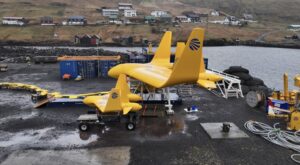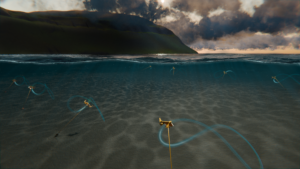Following three months of testing, Minesto’s megawatt-scale tidal energy kite ‘delivering as expected’
Minesto’s 1.2 MW Dragon 12 tidal powerplant has delivered as expected in its first three months of operations and the data being generated underlines the commercial readiness of Dragon Class systems, the Swedish company reported.

The 1.2 MW powerplant was installed and commissioned at the site in Vestmanna, Faroe Islands, in early February, which has resulted in an ongoing trouble-free three-month period of testing and electricity production, generating valuable results and data to underline commercial readiness of Dragon Class technology at commercial scale, Minesto said.
Real test data from the commercial scale D12 is now available to customers and is used to show autonomous functionality, product performance, and service interval analysis.
“With the generated test data at hand, we can now conclude that Dragon Class is ready for batch production to bring the first tidal energy arrays to life,” said Martin Edlund, CEO of Minesto.
Moreover, the large Dragon 12 is accompanied by a smaller Dragon 4 of 100 kW in the Vestmanna strait, which means that two systems are installed and grid-connected in parallel, making what is said to be the world’s first mini array of tidal energy kites in operation.
According to Minesto, operating two systems in parallel contributes to new ways of verification and learning in core areas, such as kite-park design, product range modularity and performance optimization.
With two systems installed, the Swedish company said it was engaged in the most active operations in company history, yet still in a cost-efficient setup – working at one site utilizing the same small-scale work vessels and quaysides for all kites.
Related Article
Minesto plans to continue electricity production and testing as an integral part of the ongoing commercial roll-out agenda. The purpose of the continued testing is to continue demonstrating the competitive advantage of Dragon class technology, secure capability to deliver commercially viable products, and push performance to further expand the exploitable market.
“It is both satisfactory and vital to see that the February installation of Dragon 12 has resulted in a three-month period of successful production testing. Our major investments in a full-scale D12 powerplant and extensive test-site infrastructure delivers full value in generating production data that show evidence of commercial readiness,” said Edlund.
“This is crucial technical data that our partners and site project investors have been asking for and we now are providing to reduce perceived risks in multiple ongoing sales and project investment-dialogues.“








